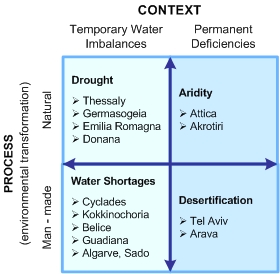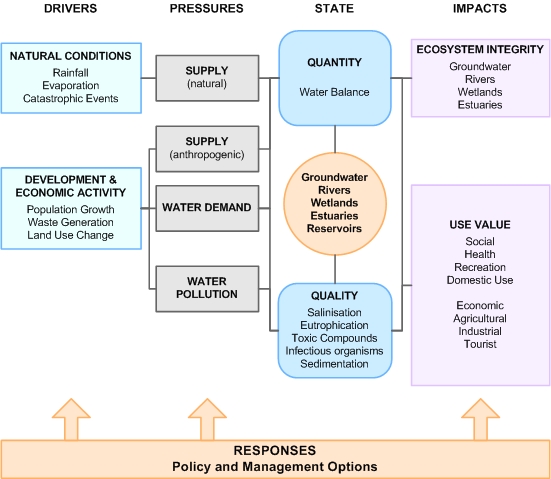
|

| |
|
The Diagnostic/Descriptive analysis was undertaken in 4 levels:
- The 1st Level involved the Comparative analysis of water stress conditions in six Southern European and Mediterranean countries (Greece, Italy, Spain, Portugal, Cyprus and Israel), and included:
- Data collection at the country and regional level, and
- The formulation of a Matrix of circumstances for 15 regions facing water stress conditions selected and analyzed within these 6 countries. These regions, selected on the basis of facing water stress, were:
- In Greece, Attica, Thessaly and the Cyclades Islands,
- In Italy, Belice basin and Emilia-Romagna,
- In Spain, Doñana and the Canary islands,
- In Portugal, Algarve, Sado and Guadiana,
- In Cyprus, Akrotiri, Germasogeia and Kokkinochoria
- In Israel, Tel Aviv and Arava.
- The 2nd Level was the development of a Typology of water deficiency types based on the characteristics of the analyzed regions,
- The 3rd Level involved a DPSIR analysis of the causal interrelationships formed under conditions of water scarcity in the analyzed regions, and
- The 4th Level involved the formulation of Paradigms of water resources management. For each of the regions analyzed, the Dominant Paradigm of Water Management was determined, and the Emerging Paradigm trends were formulated, as proposed by local stakeholders.
Finally, after the elaboration of water deficiency types and the DPSIR causal interrelationship analysis, Case Study regions were selected from the 15 proposed and analysed regions.
|
| |
| |
|
Water stress conditions and the spectrum of circumstances were analysed in the 6 countries and within the specific regions. The main observation made was that aridity should be understood in a wider context encompassing both natural and man-made processes. Various concepts have been used to exemplify a prevailing confusion among such terms which signify dry environments or water deficiencies. The terms vary all the way from the extremes of desert to aridity, to drought and to temporary water shortages. There are four different terms that are important to the initial separation between physical and social conditions with regard to what one can summarily label water deficiencies:
- Aridity, signifying a permanent natural condition and a stable climatic feature of a given region,
- Drought, referring to a temporary feature of the climate or to regular or unpredictable climatic changes,
- Water shortage, a term that can be understood mostly as a man-made phenomenon reflecting the concern with temporary and small area water deficiencies, and
- Desertification, as a process of alteration of the ecological regime often associated with aridity and/or drought but principally brought about by man-made activities which change the surrounding ecosystem to a significant degree.
At the same time, responses to water deficiency problems, technological and social, as well as legal mechanisms for carrying out management schemes tend to fall under the following four major categories:
- Strong incentives for efficient or new uses, including economic benefits, redefinition of the doctrine of beneficial use, etc.
- Structural changes, such as new organizational arrangements, creation of new water agencies, etc.
- Regulatory counter incentives, such as stricter enforcement and pricing policies.
- Changes in water lifestyles and cultural practices.
Top
|
| |
| |
|
The range of circumstances in the 15 regions was analyzed on the basis of a series of well-defined indicators describing various issues of water management, such as water availability, water quality, use patterns and types of demand pressures (seasonal, permanent), pricing systems and tariffs, social capacity building, and institutional framework (water competent authorities, decision making processes and development priorities).

Figure 1. The proposed typology of water stress conditions
On the basis of the spectrum of water management circumstances and the DPSIR causal interrelationships in the 15 regions, a typology for water stress conditions was proposed (Figure 2) that follows the above analysis of water stress conditions. The typology categorises the 15 regions into four broad Types with respect to the processes leading to water stress, and to the water stress context - man-made or natural processes, causing temporary or permanent water deficiency.
Top
|
| |
| |
|
A detailed analysis was pursued for the 15 selected regions, in terms of water management practices.
The causal interrelationships occurring were formulated in a DPSIR scheme (Figure 1), and special attention was given in the establishment of common and well structured set of indicators and indices that allowed the presentation of the causalities between Pressures/Drivers and Impacts.

Figure 2. The DPSIR scheme adopted in the investigation of causal interrelationships for the water stress conditions in the 15 regions
Top
|
| |
| |
|
Following the elaboration of water deficiency types and the DPSIR causal interrelationship analysis, Case Study regions were selected from the 15 proposed and analysed regions. A Case Study involves the application and analysis of a Water Resources Management Paradigm on the selected Region and its specific characteristics. It was important to select a set of regions that represent the widest possible range of water stress issues and conditions and their combinations, in order to ensure that the lessons learned from the Case Studies would have the widest applicability possible. To that end, the following six regions were selected:
- Paros Island in the Cyclades complex was selected in Greece, where the main water stress issue is the peak in demand during the summer months, due to the high tourist influx onto the island. The existing infrastructure capacity is stretched during that period and is often insufficient to cover demand at peak times, leading to temporary shortages that in return are damaging to tourism.
- Cyprus was eventually selected as a whole, in order to analyse the effects of the competition for water resources between tourism and agriculture, the two major sources of income of the island, and determine the potential for a compromising water management solution that will be beneficial to both sectors.
- Ribeiras do Algarve was selected in Portugal, where despite the relative abundance of water resources, salinity of the underground aquifers is a rapidly intensifying problem due to the over-abstraction of water for use in golf courses and other tourism-related uses.
- Tel- Aviv and the Arava region were eventually both selected for Israel, to be analysed with respect to the conflicts arising between the provision of water for urban water supply and for agriculture irrigation in a country where water is a very scarce and valuable resource.
- Belice Basin in Italy was selected, where the major water stress reason is the peak in demand during the summer, due to irrigation demands in the region.
- Finally, Tenerife in the Canary Islands was selected in Spain, where the year-round high water demand is caused by a tourist influx much larger than the local population, demanding large infrastructure that nevertheless needs to be paid for by the locals.
Top
|
| |
|